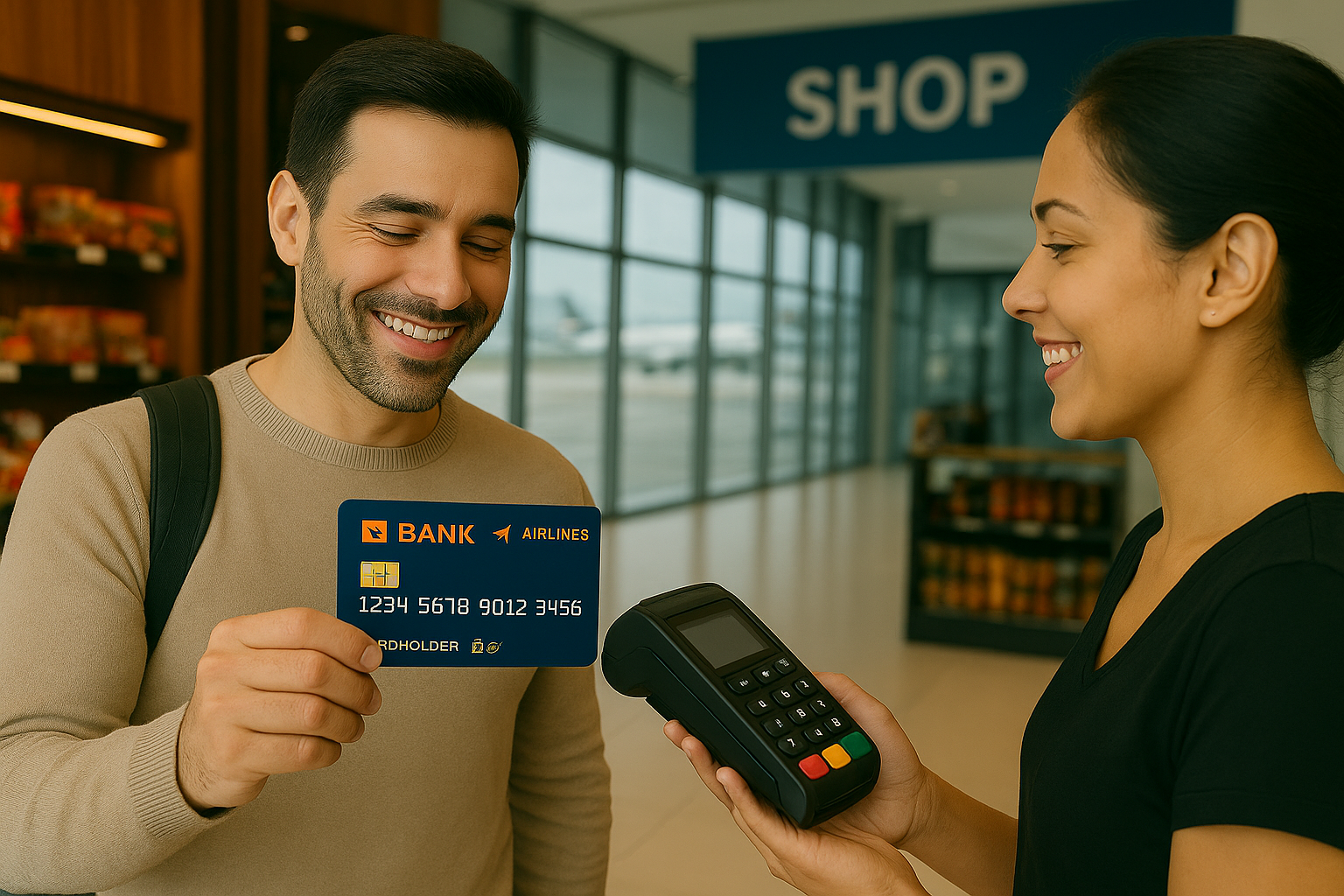Co-branded credit cards in loyalty have been around for over 45 years and remain a story of continued success. As a powerful extension of airline loyalty initiatives, they generate billions in annual revenue and, in some markets, contribute more than a half of total program earnings.
In this article, we’ll give a short introduction into the concepts, explore the practice and experiences, and finally look at emerging developments and their already existent or potential impact on co-branded credit cards in loyalty.
How do co-branded credit cards work
Co-branded credit cards are partnerships between card issuers, e.g., banks, and brands with loyalty programs, like airlines or retailers. They offer cardholder rewards, such as points or miles, directly linked to the partner’s loyalty scheme.
There are several stakeholders involved: the member (as card holder), the merchant, the acquirer (merchant bank), the credit card provider (e.g., VISA), the card issuer (typically a bank), and the loyalty program as the co-brand partner.
As outlined in the introduction, the additional revenue created is significant, and it comes from
- Interchange fees: the card issuer earns a fee from merchants each time the card is used for a transaction
- Interest and fees: revenue is generated from cardholders’ interest on revolving balances and annual fees.
- Partner funding: the co-brand loyalty program partner sells loyalty currency to the card issuer, typically at a negotiated bulk rate. This enables the issuer to award these to members. For the loyalty program this represents upfront revenue.
There is also an indirect positive effect on the revenue stream coming from customer data and engagement: Both parties benefit from greater insight into customer behavior, enabling better targeting, cross-promotion, and marketing.
A strong, well-executed co-branded credit card can act as a status symbol, enhancing the brand’s reputation and customer prestige.
64% of consumers are more likely to recommend brands with strong loyalty programs.
The benefits of co-branded credit cards
For the loyalty program
Reach
Co-branded credit cards embed loyalty programs into everyday life, transforming members with only occasional engagement into regular cardholders, resulting in more frequent interactions, higher transaction volumes, and increased revenue.
Revenue
It pays into the “Top-of-Wallet” competition: Cardholders spend more overall and allocate a larger share of their discretionary spending to the co-brand card. A Canadian study found co-brand cardholders increased loyalty program behavioral activity by 17% and perceived generosity by 41% compared to non-cardholders.
Increased transaction volume leads to higher revenue from interchange fees, interest, and annual fees, benefiting both issuers and loyalty program brands.
Reputation
A strong, well-executed co-branded credit card can act as a status symbol, enhancing the brand’s reputation and customer prestige.
64% of consumers are more likely to recommend brands with strong loyalty programs.
Know-Your-Customer
Every card transaction provides granular data that brands can leverage to understand customer behavior beyond their own offerings, helping tailor personalized promotions and marketing efforts effectively.
This data integration supports omnichannel loyalty strategies, connecting in-store, online, and mobile engagement seamlessly.
For the card issuer and credit card provider
Revenue
Card issuers benefit from increased amount of interchange fees, interest, and annual fees.
Marketing
The tighter integration between financial and loyalty ecosystems enables joint marketing campaigns with the loyalty program, co-investment in acquisition efforts, and stronger ongoing customer communication.
For the member
More options to accrue
The increased reach of the loyalty program allows members to accrue bonus currency faster, everywhere and every day. Depending on program rules, status currency can be accrued as well. Therefore, there is a higher flexibility for the member to reach.
They accelerate accumulation of points or miles, which leads to faster redemptions.
A co-branded credit card enables additional benefits granted by the card issuer (e.g. insurances, VIP events), enhancing the perceived value of the loyalty program and the brand’s exclusivity.
Co-branded credit cards in practice - Do’s and Dont’s
This section focuses on the best practices with respect to the partnership of co-branded credit cards and the loyalty program.
The Do's
The formula for success of co–branded cards in loyalty programs comprises
- Aligned Partner Goals:
Both issuer and brand share clear, complementary objectives and target segments.
- Mutually Beneficial Reward Structure:
Develop compelling earn and redemption mechanics that showcase the strengths of both parties. Benefits should be relevant and attainable, balancing costs and driving frequent usage with clear incentives for program spend.
- Mutually Beneficial Financial Structure:
Clear sharing of costs, revenues, and credit risk to sustain long-term partnership.
- Seamless User Experience:
Easy enrollment, use, and reward redemption integrated with digital channels.
- Data-Driven Personalization:
Utilization of combined data for personalized offers and risk assessment.
- Strong Partner Collaboration:
Coordinated marketing, cost/revenue sharing, and operational integration.
- Ongoing Optimization:
Continuous tracking and refinement based on performance metrics and customer feedback.
The Challenges
Benefits may not outweigh costs: If co-branded credit cards come with higher annual fees and interest rates compared to general-purpose credit cards, this can outweigh benefits, especially if customers carry balances or do not use the card frequently enough.
Growing fatigue with chasing loyalty status: Consumers show growing fatigue with chasing loyalty status, especially in sectors like airlines where accrual options have decreased and thresholds increased to achieve a certain status. Most airline loyalty programs allow members to earn only redeemable miles, not status miles, which limits the impact of co-branded cards. Connecting card activity to status miles and introducing mechanics such as mile-to-status conversion and targeted campaigns is therefore crucial to boost their appeal.
Indirect customer relations for program providers: Since the card issuer usually manages the customer relationship, brands do not have direct control over customer service quality and experience. There is a risk for brand reputation if cardholder experiences are poor.
Current Developments - What is Changing?
While all the well-known developments of loyalty programs and credit cards market apply, there are some which arise from the interworking of both, and also from developments in payment and banking, for the concept of co-branded credit cards for loyalty programs:
Mobile-first onboarding is now standard, allowing customers to apply, receive, and use co-branded credit cards instantly in digital wallets. Instant digital issuance of co-branded credit cards (virtual cards) and wallet integration (Apple Pay, Google Pay, virtual-only cards) will be standard, enabling immediate use and frictionless integration with loyalty apps. The downside of this: the co-brand is no longer visible to others which reduces the visibility of issuer and brand.
Fintech firms will become frequent co-brand partners, accelerating innovation in issuance speed, digital capabilities, and reaching previously underserved demographics.
New cards allow payment splitting among multiple sources or users, which requires robust, real-time reward calculation. This method allows customers to pay a single transaction using multiple funding sources, for example, partly with a co-branded credit card, partly with loyalty points, and partly with another payment method.
Another splitting option allows a customer to distribute the payment over various customers, e.g., for paying for a group trip.
BPNL (Buy Now Pay Later), one of the most transformative recent innovations, allows consumers to split purchases into installment payments, often interest-free for a short period of time. Co-branded credit cards and issuers are experimenting with ways to embed loyalty rewards into BNPL payments, either by offering points on BNPL transactions or hybrid products combining BNPL and credit features. Fintechs like Sunbit are creating co-branded credit cards specifically designed to integrate BNPL features with loyalty programs for sectors like retail and automotive repair.
Also, BNPL services are increasingly partnering with co-branded programs, sometimes offering their own loyalty schemes and driving new hybrid “pay later & rewards” loyalty models.
Open Banking enables the secure, consent-driven sharing of financial information – such as transaction history, account balances, and spending habits – with authorized third-party providers (TPPs) through Application Programming Interfaces (APIs). Open Banking enables consumers to make payments directly from their bank accounts, bypassing traditional card rails. We anticipate it will change co-branded credit cards and loyalty programs significantly, as this may reduce transaction volume on co-branded credit cards as account-to-account payments become more seamless and accepted.
Co-branded credit cards will need to deliver enhanced value like instant rewards or exclusive perks and benefits to remain front-of-wallet. A loyalty programs may shift toward brand-funded or ecosystem-funded incentives, changing how reward economics are structured.
Conclusion: Now Is the Moment
Loyalty programs and co-branded credit cards will increasingly function as holistic engagement platforms, merging payment, data, marketing, and service touchpoints for everyday use, not just for big-ticket or travel spending, creating lasting value for brands and consumers alike.
In a rapidly changing payments landscape shaped by emerging technologies like open banking, BNPL, and debit-based rewards successful programs will be those that integrate seamlessly across channels, adapt to evolving consumer preferences, and maintain transparent, fair, and compelling value propositions. Ultimately, the fusion of co-branded credit cards and loyalty programs remains one of the most effective ways for brands to build durable customer relationships and thrive in competitive markets.
Discover how we help airlines unlock the full potential of co-branded credit cards. Learn more here.






